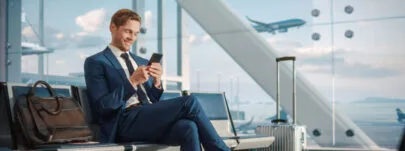
Traveling with a CPAP Machine: Does It Count as Carry-on Luggage?
CPAP is a leading treatment for obstructive sleep apnea. It uses a machine that delivers pressurized air through a mask to prevent the collapse of the upper airways as you sleep.
This removes the breathing interruptions caused by obstructive sleep apnea and reduces the risk of the health complications linked to this sleep disorder.
You do not need to forgo your treatment when you travel. Whether going away on vacation or flying for business you can take your CPAP machine — or a portable device — with you.
Flying with these machines is permitted by the Transportation Security Administration (TSA).
Why You Should Pack Your CPAP Machine
Just a single night without CPAP can cause the return of your sleep apnea symptoms – including snoring, as well as daytime fatigue. Although it can be tempting to leave your sleep apnea treatment equipment at home, a return of your symptoms could ruin any trip.
If you aren’t keen on carrying your regular machine, talk to your sleep doctor about the possibility of a more compact portable machine.
Is CPAP Classed as Carry-on Luggage?
It is recommended by the TSA that you board a flight with your CPAP machine as carry-on luggage. However, as we are talking about a medical device, technically it can’t be considered as carry-on like your other personal belongings.
Therefore, it is best packed in a separate travel case, leaving more space in your carry-on bag.
A good reason to take the machine as a carry-on is the risk of luggage getting lost. If you have the machine with you at all times during the flight, there is less chance of it being damaged or stolen too. You don’t want to arrive at your destination and find your machine isn’t waiting for you.
On long flights, you may also want to sleep and therefore use your machine. Having your machine as a carry-on — and not with your luggage – allows you to arrive at your destination refreshed and raring to go.
How to Travel with CPAP
All it takes is a little additional planning to ensure you can keep your sleep apnea under control when you travel. While airport staff and flight officials are increasingly familiar with these medical devices, it is still a good idea to take a copy of your prescription with you.
Another useful document to carry is a printout of the manufacturer’s FAA compliance. It is highly unlikely you will need to show such documentation, but it provides a just-in-case level of insurance for unhindered travel.
If you plan on using your machine during the flight, phone the airline in advance to confirm their policy. While the airline must allow you to take your machine on board with you, their policy on in-flight use will rule.
If your machine operates with a humidifier, you will need to have a small quantity of distilled water packed in your carry-on bag. You are allowed to pack 3.4 oz of water. Before packing you should empty any water from the humidifier, as this helps prevent mildew or mold from forming or could damage the device.
Another advantage of having a portable machine for traveling is that you can obtain models which feature a waterless humidifier. They work by using the moisture from your breath to help moisten the air delivered to your airways. Not only do you have a more compact machine to carry, but you don’t have to pack additional water.
What to Expect at the Airport
Your machine will still be subjected to the usual airport security measures. As this will involve taking it out of its travel case for scanning, you can either bring a clear plastic bag or have it already packed in a clear plastic bag.
Placing your machine in a plastic bag helps with hygiene as the bins are not the most sterile environment. You will not be required to remove your mask and tubing from the case.
The x-ray may not be the only security procedure your machine is required to undergo. It may need to be tested for any trace of explosives.
In this case, the security officers will need to open the clear plastic bag to swab your machine. You are permitted to ask that a clean swab is used and that the officers wear a fresh pair of gloves.
Similar to taking the relevant documentation, a medical tag identifying the type of machine you are carrying may speed up the security procedure. However, airport staff are increasingly aware of such machines and should recognize them.
Additional Travel Tips
Planning makes for a smoother journey and stay when away from home. The following are a few more traveling tips.
- Check if you need a power adapter. This is particularly important if you are intending to fly internationally. You don’t want to arrive and then have to hunt for an adapter to power up your machine when you could be enjoying your trip instead.
- Check in advance that there are accessible in-flight power sockets for your seat if you intend to use your machine on the plane
- Take enough additional supplies to last the duration of the trip. This includes wipes, mask cushions and filters.
- Take a backup battery pack in case of any unforeseen issues with the power supply when away. This way you limit the chance of your sleep being disrupted due to the return of your obstructive sleep apnea symptoms.
- Buy bottled water after you pass through airport security.
CPAP should not just be a home remedy. With a little preparation, you can benefit from your sleep apnea treatment plan when traveling, ensuring proper nights of rest when you are away from home.
Sources:



